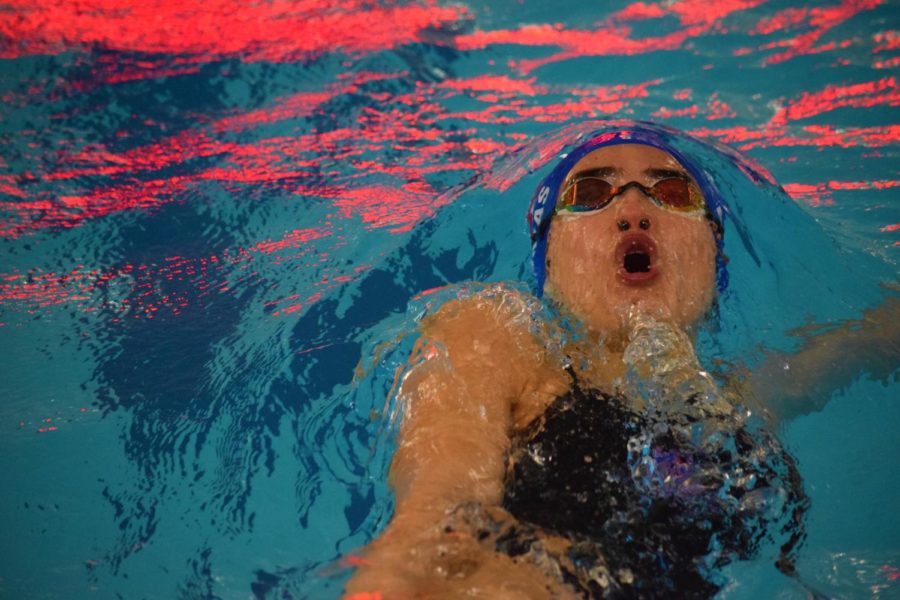To say senior Teagan Steinmetz is fast is an understatement. At her last meet, the state championships, she swam an impressive 51.5 seconds anchoring the winning 400 free relay.
But the referees may not only have been watching the championship-winning swim. Instead, they may have been looking at her body, or more accurately, the way her suit looked.
The National Federation of State High School Associations (NFHS), which rules over swim meets alongside Colorado High School Activities Association (CHSAA), renewed a rule that swimmers on the girls’ and boys’ teams must wear swimsuits that provide certain amounts of coverage.
“Females shall wear suits which cover the buttocks and breasts and shall not extend beyond the shoulders or below the top of the kneecap, nor cover the neck,” says Article 2 of the Uniform Rules in the NFHS swimming bulletin for the 2022-23 season.
Creek’s head girls’ swim coach Karin Olmsted is strongly opposed to the guidelines. “We’re here to swim, we shouldn’t be telling the girls if a suit fits, or that it should fit a certain way based on who they are, and how they’re made,” she said.
Suits are often made in selective sizing, or with one-size-only options. This makes suit wearers not only starved for larger selections but often very uncomfortable.
“If you’re sitting around at a meet for multiple hours, those suits are meant to be compressive. And it’s very uncomfortable,” Steinmetz said. “There are just so many rules to make you more uncomfortable.”
This policing of swimmers’ bodies has become a central point in recent years. One case, mentioned several times by Olmsted, occurred in 2019 when a female Alaskan high school swimmer was disqualified over a swimsuit violation. This ruling was widely debated, and the Anchorage School District, under which the swimmer competed, released a statement saying, “The disqualification appears to stem from a difference of opinion in the interpretation of the rules governing high school swim uniforms.”
This mirrors Olmsted’s arguments against the opinion-based standard that referees who employ the ruling use. “I just think it becomes very subjective, from one person’s subjectivity to another as to what is approved or not approved,” Olmsted said. “Young females under the age of 18 should not be subjected to that.”
“[Swimmers] have multiple old men staring at girls from ages mostly 14 to 18 years old,” junior Charlotte Wilson said. Wilson is one of the foremost swimmers in the state as well as a member of a different champion winning free relay, which broke the state record.
The Union St. Journal reached out to CHSAA’s Rules Interpreter Bill Christie, who declined to comment on the rule.
For Steinmetz, it was very odd to have coaches and referees comment on her body. “As a freshman, my male coach was telling me, ‘Hey, just make sure all of you guys are covering enough because you don’t want to get disqualified for that,’” she said. “Why aren’t you looking at the dive? Why are you worried about the suit coverage?”
Wilson feels the same. “It’s really uncomfortable for me to know that these people have been told by CHSAA to watch our bodies and how our suits look on them,” she said.
Another issue this rule creates is the lack of body positivity involved in enforcing the rule. “I think a really tall [athlete] with a really long torso is going to wear the suit very differently than somebody who’s 5’2,” Olmsted said. “You can’t fit that person in the same suit.”
“Everyone’s bodies are different. It’s not fair to expect that the same suit fits everyone the same,” Steinmetz said.
Their other main issue is that the rule assumes that a swimmer looks to be provocative when wearing a suit. “I don’t think anyone on a high school team is there to show things off,” Steinmetz said. “I don’t think anyone’s purposely trying to pull their suit up and have their entire butt hanging out.”
“If their suit rides up a little bit or their suit moves a little bit that could be considered disqualification just because their suit moved because they’re being athletic,” Wilson said.
For Olmsted, officials should only police the sport. “We should officiate what’s in the pool, not what’s out of the pool,” she said.
The current CHSAA rules meddle with and confuse swimmers as to what the goal of their meets is. “Aren’t you supposed to be judging the swim?” Steinmetz said. “It shouldn’t be judging the body of the swimmer. That’s not the sport.”
This story was originally published on Union Street Journal on March 11, 2023.




































